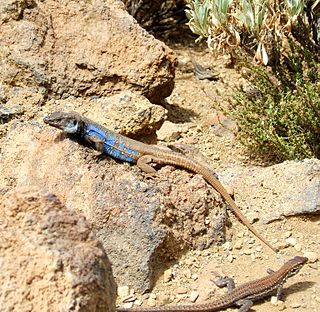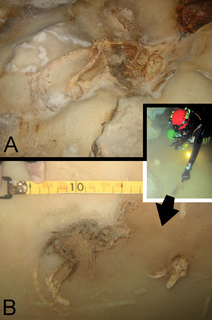
The genus Gallotia are the lacertids of the Canary Islands. This genus consists of a group that has been evolving there ever since the first islands emerged from the sea over 20 million years ago. The endemic species and subspecies of this group have a number of characteristics that make them quite special within their family (Lacertidae); their only close relatives are the sandrunner lizards (Psammodromus) of the western Mediterranean region. Gallotia are characteristic for eating significant quantities of plants, and for several lineages having evolved insular gigantism.

The Columbretes Islands (Valencian: Les Columbretes, IPA: [les kolumˈbɾetes] or Els Columbrets, are a group of small uninhabited islets of volcanic origin, in the Mediterranean Sea, 49 kilometres off Orpesa. Administratively they belong to Castellón de la Plana in the Valencian Community.

Vipera is a genus of vipers. It has a very wide range, being found from North Africa to just within the Arctic Circle and from Great Britain to Pacific Asia. The Latin name vīpera is possibly derived from the Latin words vivus and pario, meaning "alive" and "bear" or "bring forth"; likely a reference to the fact that most vipers bear live young. Currently, 21 species are recognized. Like all other vipers, the members of this genus are venomous.

Vipera ammodytes is a viper species found in southern Europe, mainly northern Italy, the Balkans, and parts of Asia Minor. Like all other vipers, it is venomous. It is reputed to be the most dangerous of the European vipers due to its large size, long fangs and high venom toxicity. The specific name, ammodytes, is derived from the Greek words ammos, meaning "sand", and dutes, meaning "burrower" or "diver", despite its preference for rocky habitats. Five subspecies are currently recognized, including the nominate subspecies described here.

Vipera latastei, known as Lataste's viper, the snub-nosed viper, and the snub-nosed adder, is a species of venomous snake in the subfamily Viperinae of the family Viperidae. The species is endemic to the Iberian Peninsula and northwestern Maghreb. Three extant subspecies and one extinct subspecies are currently recognized, including the nominate subspecies described here.

Unión Deportiva Ibiza-Eivissa was a Spanish football team based in Ibiza Town, in the autonomous community of the Balearic Islands. Founded in 1995, it last played in Regional de Ibiza, holding home matches at Estadi Municipal de Can Misses, with a capacity of 10,000 seats.

The Balearic Islands are an archipelago in the Balearic Sea, near the eastern coast of the Iberian Peninsula. The archipelago is an autonomous community and a province of Spain; its capital is Palma. The 2007 Statute of Autonomy designates the Balearic Islands as one of the nationalities of Spain. The official languages of the Balearic Islands are Catalan and Spanish.

Santa Cruz del Islote is an artificial island located off the coast of Bolívar Department in Colombia, close to Tolu and Coveñas. It is a part of the Archipelago of San Bernardo. Its large population for its size has given it notoriety for supposedly being the most densely populated island on earth; however, estimates of its population vary greatly.

The 2011 Balearic regional election was held on Sunday, 22 May 2011, to elect the 8th Parliament of the autonomous community of the Balearic Islands. All 59 seats in the Parliament were up for election. The election was held simultaneously with regional elections in twelve other autonomous communities and local elections all throughout Spain.

Hypnomys, otherwise known as Balearic giant dormice, is an extinct genus of dormouse (Gliridae) in the subfamily Leithiinae. Its species are considered examples of insular gigantism. They were endemic to the Balearic Islands in the western Mediterranean from the Early Pliocene until their extinction around 4,000 years ago. They first appeared in the fossil record on Mallorca during the Early Pliocene, presumably due to the Messinian salinity crisis causing a connection with mainland Europe. They later spread to Menorca, and a possible molar is also known from Ibiza. Hypnomys became extinct during the Holocene after human arrival on the Balearics. They were one of only three native land mammals to the islands at the time of human arrival, alongside the shrew Nesiotites and goat-antelope Myotragus.

The 2019 Balearic regional election was held on Sunday, 26 May 2019, to elect the 10th Parliament of the autonomous community of the Balearic Islands. All 59 seats in the Parliament were up for election. The election was held simultaneously with regional elections in eleven other autonomous communities and local elections all throughout Spain, as well as the 2019 European Parliament election.

The 1991 Balearic regional election was held on Sunday, 26 May 1991, to elect the 3rd Parliament of the autonomous community of the Balearic Islands. All 59 seats in the Parliament were up for election. The election was held simultaneously with regional elections in twelve other autonomous communities and local elections all throughout Spain.

The 1995 Balearic regional election was held on Sunday, 28 May 1995, to elect the 4th Parliament of the autonomous community of the Balearic Islands. All 59 seats in the Parliament were up for election. The election was held simultaneously with regional elections in twelve other autonomous communities and local elections all throughout Spain.

The 1999 Balearic regional election was held on Sunday, 13 June 1999, to elect the 5th Parliament of the autonomous community of the Balearic Islands. All 59 seats in the Parliament were up for election. The election was held simultaneously with regional elections in twelve other autonomous communities and local elections all throughout Spain, as well as the 1999 European Parliament election.

The 2003 Balearic regional election was held on Sunday, 25 May 2003, to elect the 6th Parliament of the autonomous community of the Balearic Islands. All 59 seats in the Parliament were up for election. The election was held simultaneously with regional elections in twelve other autonomous communities and local elections all throughout Spain.

The 2007 Balearic regional election was held on Sunday, 27 May 2007, to elect the 7th Parliament of the autonomous community of the Balearic Islands. All 59 seats in the Parliament were up for election. The election was held simultaneously with regional elections in twelve other autonomous communities and local elections all throughout Spain.
The 2011 Balearic Island Council elections were held on Sunday, 22 May 2011, to elect the 9th Island Councils of Mallorca and Menorca and the 2nd Island Councils of Formentera and Ibiza. All 72 seats in the four Island Councils were up for election. The elections were held simultaneously with regional elections in thirteen autonomous communities and local elections all throughout Spain.
In the run up to the 2015 Spanish local elections, various organisations carried out opinion polling to gauge voting intention in local entities in Spain. Results of such polls for municipalities and island councils in the Balearic Islands are displayed in this article. The date range for these opinion polls is from the previous local elections, held on 22 May 2011, to the day the next elections were held, on 24 May 2015.
In the run up to the 2015 Spanish local elections, various organisations carried out opinion polling to gauge voting intention in local entities in Spain. Results of such polls for municipalities and island cabildos in the Canary Islands are displayed in this article. The date range for these opinion polls is from the previous local elections, held on 22 May 2011, to the day the next elections were held, on 24 May 2015.

The Hungarian meadow viper, also called the Danubian meadow viper is one of the eight subspecies of the Vipera ursinii. It is an extremely rare venomous viper that can mostly be found in Hungary. The Hungarian meadow viper is the most endangered species in the whole Pannonian Basin. It was scientifically recorded for the first time in 1893 by Lajos Méhelÿ, Hungarian zoologist. In 2004, its entire Hungarian population was estimated to be below 500 specimens.















